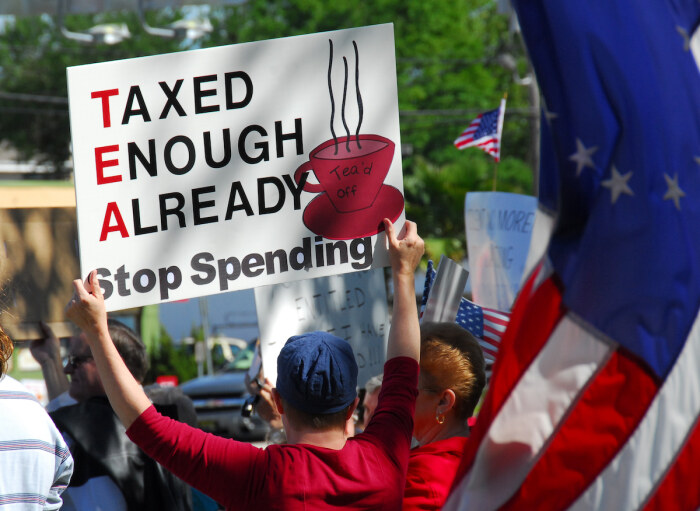Jim Chrisinger reviews The Tea Party and the Remaking of Republican Conservatism, by Theda Skocpol and Vanessa Williamson (2012).
In a backlash to President Barack Obama’s election and Democrats gaining control of the U.S. House and Senate, the Tea Party movement yanked the Republican Party to the right and paved the way for Donald Trump and Trumpism.
During Obama’s first term, from 2009 through 2012, three forces reinforced each other: Tea Party grassroots activism, billionaire-funded national advocacy organizations pushing ultra-free-market policies (tax cuts for the wealthy, deregulation, and deep cuts to federal spending), and right-wing media, primarily Fox “News.”
Early on, especially when Tea Partiers disrupted Congressional Democrats’ home district meetings in August 2009 protesting health care reform plans, there was confusion in the media about who these people were and what the Tea Party meant. Some early polling suggested the Tea Party included many independents, prompting speculation it could become a powerful third force in American politics, maybe even a third party.
That perception probably gave the Tea Party more credit for the 2010 Republican landslide than warranted. It later became clear that the Tea Party consisted almost exclusively of hard-right Republicans.
Tea Party faithful provided a ground game and great visuals for the plutocrats’ national advocacy groups and the local Tea Parties received funding and other tactical assistance in return. Fox News directly and actively promoted the Tea Party and provided the Tea Partiers with a worldview and “facts” that played to their beliefs. The Tea Party provided right-wing media with colorful images and the impression that their promotion of Republicans was backed by new adherents.
Tensions between some of the plutocrats’ policy ideas, like privatizing Social Security and Medicare, bumped up against the fact that the Tea Partiers did not much like those policies.
Internal tensions surfaced within Tea Party groups between social conservatives and libertarians. These two groups’ accommodation of each other stood in contrast to both these groups’ inability to see others, especially Democrats, as having any legitimacy in the political process.
The Tea Party was most influential in Republican primary elections, where activists pulled the field to the right. But they could be a detriment in the general election if the Tea Party’s candidates were too extreme, e.g. candidate Christine “I’m not a witch” O’Donnell, who lost the 2010 Delaware Senate race.
Tea Partiers were primarily older, white, middle-class, and educated. They were extremely conservative. They combined admirable grass-roots engagement with wildly uninformed or just plain wrong views about what government does and how, how much it costs, the contents of laws like the Affordable Care Act (they claimed Obamacare included “death panels” and a public option), and impressions of Democrats like Obama.
Many wrongly labeled Obama a Muslim or a socialist. In any case, they asserted, he was not a real American. They despised compromise and other democratic norms. They were as committed to beating establishment Republicans as beating Democrats.
They believed their country was under existential threat, from fiscal ruin, demographic invasion, and socialist redistribution. They feared their taxes would be raised to provide benefits to undeserving people, especially people who didn’t look like them. They believed they’d already paid for what they received from the federal government, such as Social Security and Medicare. Other benefits for minorities and younger folks were unearned and therefore wrong. Their crusade was moral as much as political.
The Tea Partiers were invariably polite to Theda Skocpol and Vanessa Williamson, the Harvard academics who wrote The Tea Party and the Remaking of Republican Conservatism. They may have been warm and generous people in their own orbits, but they could be downright cruel in their stereotypes about minorities, immigrants, and young people. They lacked empathy for those unlike themselves. They were driven by hatred and fear of Obama and other changes in American society.
It’s impossible to read this book, which was published in 2012, without feeling like you are reading about MAGA supporters. They’re the same people. And the same triple synergy of grass-roots activism, roving billionaires, and right-wing media remains just as pervasive and potent.
Jim Chrisinger is a retired public servant living in Ankeny. He served in both Republican and Democratic administrations, in Iowa and elsewhere.
Top image: Protesters attend nationwide rally against increased government spending in Pensacola, Florida on tax day, April 15, 2009. Photo by Cheryl Casey, available via Shutterstock.

